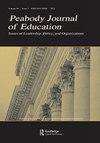一场好的危机:紧急情况与美国高等教育的重构,1944-1965
Q2 Social Sciences
引用次数: 0
摘要
摘要所谓的美国高等教育“黄金时代”,通常与二战后的二十年联系在一起,其标志是联邦政府对美国高等教育机构及其学生越来越慷慨的支持。与将这种慷慨归因于地缘政治(即对冷战的回应)或人口统计(即为适应婴儿潮一代而进行的扩张)等因素的分析不同,本文认为,植根于言论的深思熟虑的策略使“高等教育党派”能够成功地在华盛顿特区推行慷慨的高等教育政策。具体而言,危机和紧急情况的语言使这些倡导者能够将上大学视为一种工具,可以解决社会和经济问题,捍卫国家及其价值观,消除偏见和不平等。他们的成功体现在1944年《退伍军人法案》发起的“政策级联”中,并在1965年《高等教育法》中达到顶峰。这篇文章依靠新的档案研究和文件分析来研究联邦政策制定的六个关键部分的轨迹,这些部分共同构成了“披着狼衣服的绵羊”,为学院和大学提供资金,以应对紧急甚至存在的危机。本文章由计算机程序翻译,如有差异,请以英文原文为准。
A Good Crisis: Emergencies and the Reframing of American Higher Education, 1944–1965
ABSTRACT The purported “Golden Age” of American higher education, typically associated with the two decades following World War II, was marked by increasingly generous federal support of the nation’s postsecondary institutions and their students. Unlike analyses that attribute this largesse to factors like geopolitics (i.e., a response to the Cold War) or demographics (i.e., expansion to accommodate the Baby Boom generation), this article argues that a deliberate strategy rooted in rhetoric enabled “higher education partisans” to successfully push generous higher education policy in Washington, DC. Specifically, the language of crisis and emergency enabled these advocates to frame college-going as a tool that could solve social and economic problems, defend the nation and its values, and chip away at prejudice and inequality. Their success is evident in a “policy cascade” initiated by the 1944 GI Bill and reaching its apex with the 1965 Higher Education Act. This article relies on new archival research and document analysis to examine the trajectories of six key pieces of federal policymaking, which together constituted “a sheep in wolf’s clothing” by couching funding for colleges and universities as a response to urgent, even existential, crises.
求助全文
通过发布文献求助,成功后即可免费获取论文全文。
去求助
来源期刊

Peabody Journal of Education
Social Sciences-Education
CiteScore
2.20
自引率
0.00%
发文量
43
期刊介绍:
Peabody Journal of Education (PJE) publishes quarterly symposia in the broad area of education, including but not limited to topics related to formal institutions serving students in early childhood, pre-school, primary, elementary, intermediate, secondary, post-secondary, and tertiary education. The scope of the journal includes special kinds of educational institutions, such as those providing vocational training or the schooling for students with disabilities. PJE also welcomes manuscript submissions that concentrate on informal education dynamics, those outside the immediate framework of institutions, and education matters that are important to nations outside the United States.
 求助内容:
求助内容: 应助结果提醒方式:
应助结果提醒方式:


